Effectiveness of glaucoma therapies varies widely
But with antimetabolites, laser surgery options and new sclerotomy procedures, options abound.
It was more than 20 years ago that Robert N. Weinreb, MD, now professor of ophthalmology at the University of California–San Diego, made a wager with a distinguished glaucoma specialist about the future treatment of glaucoma.
“My colleague advocated the idea that glaucoma was a disease that would largely be treated surgically in the future, but I advocated the medical treatment position. Twenty-one years later, I still don’t believe we have an answer,” Dr. Weinreb said. Today, “medical and surgical therapy work well together when provided in a staged and rational approach to individual patients,” he said.
In the past 5 years, “there have been dramatic changes in our ability to diagnose glaucoma at an earlier stage. For most patients, earlier diagnosis means earlier treatment, which improves the prognosis,” Dr. Weinreb said. He and other glaucoma experts agreed, in interviews with Ocular Surgery News, that while there is still much to learn about glaucoma diagnosis and treatment, generally patients and physicians have more resources at their disposal now than ever before.
Dr. Weinreb cautioned that “the history of glaucoma surgery is replete with reports of one surgical success after another. Many of these reports describe techniques that are poorly validated and have not been studied in randomized controlled trials. They also lack longitudinal follow-up over a period of several years.”
Some recently proposed surgical procedures, such as holmium sclerotomy, “were originally touted as uniformly successful with few complications, but these procedures did not stand the test of time. When evaluated systematically in controlled studies over a period of years, they disappeared from practice,” Dr. Weinreb said. He is equally cautious about several newly introduced procedures such as deep sclerectomy, nonperforating schlemmectomy and excimer laser deep sclerectomy.
Standard trabeculectomy still offers a high chance of success when performed by an experienced surgeon. “There is a relatively low short-term complication rate. But the potential for long-term complications with trabeculectomy, particularly infection, are driving the development of surgical procedures that can be performed more simply and may pose less risk of long-term complications, along with better quality of life and better prognosis. However, each of these new procedures should be validated in controlled clinical trials,” Dr. Weinreb said.
Laser therapy underused
Eve J. Higginbotham, MD, professor and chair of ophthalmology at the University of Maryland in Baltimore, believes that laser glaucoma therapy is underappreciated.
Argon laser trabeculoplasty “should be reconsidered for early treatment of glaucoma patients because it does not rely on patient compliance. Even though we have much better glaucoma medications these days, there is the ongoing problem of compliance,” Dr. Higginbotham said. Adverse side effects of certain medications are also avoided with laser.
Argon laser trabeculoplasty effectively lowers IOP in 80% of patients with primary open-angle glaucoma, but the effect wears off over time, Dr. Higginbotham said. This therapy also dampens the amplitude of IOP variation, “which has been shown to be one of the primary factors that contribute to the progression of glaucoma,” she said.
Dr. Higginbotham is enthusiastic about the possibility of a laser procedure that can be repeated. “Unfortunately, in as many as 30% of patients, the argon laser has a high incidence of increased pressure when repeated,” she said. But selective laser trabeculoplasty is a procedure that uses a frequency-doubled Nd:YAG laser and averts increased pressure when repeated. “This procedure is currently under consideration for FDA approval,” Dr. Higginbotham said.
Laser cycloablative procedures are promising, but “regarding endoscopic cyclophotocoagulation, there is not as yet a significant amount of long-term experience. With cycloablative techniques, you still have the difficulty of predicting how much decrease in pressure you will achieve based on the ciliary processes that are actually ablated, so there is a level of unpredictability. Thus if one has the option of performing a trabeculectomy, this will offer slightly more reliability,” Dr. Higginbotham said. For end-stage patients, she prefers a transscleral cycloablative procedure that does not require intraocular intervention.
Drainage devices
Investigational drainage devices such as the AquaFlow collagen implant (STAAR Surgical, Monrovia, Calif.) and the cross-linked hyaluronic acid SKGel implant (Corneal, Paris) have also proven effective in maintaining constant aqueous drainage and consistently low IOP. The smaller AquaFlow, used in conjunction with deep sclerectomy, avoids many complications of standard trabeculectomy, said R. Gale Martin, MD, in private group practice in Pinehurst, N.C.
Dr. Martin has used deep sclerectomy with the AquaFlow device for the past 4 years, and the implant procedure has now replaced trabeculectomy as his technique of choice. “I perform a deep scleral resection on about 98% of my open-angle glaucoma cases. You’re dealing with a procedure in which literally the next day the patient can go play tennis. The doctor does not need to remove stitches. You’re saving both the patient and surgeon a lot of inconvenience. The extra time you spend in surgery is really well worthwhile for the majority of patients,” Dr. Martin said.
Dr. Martin took part in an 18-month follow-up study of patients implanted with the AquaFlow starting in 1996. Results showed that in a series of 76 consecutive patients, pressure was under control in 98% (21 mm Hg or less), and 91% were completely off medications. “Our average pressure was 15 mm Hg, and those still on medicine mostly took one drop twice a day,” Dr. Martin said. There also were no cases of hyphema or flat anterior chamber. “Looking back, I found this almost impossible to believe,” he said.
During this entire series Dr. Martin performed minimal unroofing of Descemet’s membrane. “But when we began to unroof more of Descemet’s membrane, the hyphema rate increased to 1% to 2%. “It is not a difficult operation, but it is more tedious. It requires more detail to the anatomy than a trabeculectomy,” Dr. Martin said. Dissecting the outer wall of Schlemm’s canal and exposing Descemet’s membrane is the main step that entails a learning curve.
Dr. Martin experimented with both silicone and PMMA implants, but both caused encapsulation. “In some cases I removed these implants,” he said. Compared to using the patient’s own scleral tissue as a wick, “there is about a 20% further reduction in pressure with the AquaFlow collagen. You actually increase both collateral flow and the filtration under the conjunctiva.”
Dr. Martin predicts that deep sclerectomy will supersede medications for most patients. “Many of our patients have difficulty paying for their medications. They are very expensive,” he said.
Antimetabolites
The use of antimetabolites to improve filtration surgery outcomes while controlling side effects is gaining popularity.
“We’ve evolved to a point where we can look at the optic nerve and consider the risk factors for the eye,” said Richard P. Wilson, MD, in private group practice and at Wills Eye Hospital in Philadelphia, “and come up with a fairly reasonable target pressure. Target pressures are usually quite a bit lower than what they used to be. For patients with serious glaucoma, they often need to be below 15 mm Hg, usually in the 12 mm range.”
To consistently achieve these low levels of pressure control, antifibrotic agents are used. “I use antimetabolites on nearly every patient,” Dr. Wilson said. “This ranges from a 5-fluorouracil (5-FU) soak for 4 to 5 minutes at the time of surgery to mitomycin 0.4 mg/cc for 4 minutes. Mitomycin is about 100 times stronger than 5-FU, but in an older patient with a primary trabeculectomy, you often don’t need to use mitomycin,” he said.
Despite the acceptance of antifibrotic agents among surgeons, Dr. Wilson is concerned that they may sometimes be overused, resulting in thin, localized blebs that can lead to bleb leaks and infections. But some practitioners underuse these agents and “end up with ocular pressures that are too high to prevent further damage,” he said.
Dr. Wilson and many of his colleagues initially thought there might be an epidemic of bleb leaks and endophthalmitis from embracing antimetabolites. “The incidence of this is increasing but has not reached epidemic proportions as yet. Our ability to modulate wound healing should lessen the danger,” he said. One technique Dr. Wilson uses to decrease toxicity and the risk of late-term complications is to expand the application area and reduce application time, especially in patients with lower risk for filter failure.
As for overall improvements in glaucoma therapy over the past 5 years, “I’m reaching my target pressure more consistently with fewer postoperative complications,” Dr. Wilson said. On the other hand, Dr. Higginbotham questions whether newer drugs and procedures have made that much of an impact. “Certainly, though, compared to 20 years ago, patients are better off,” she said.
Added Dr. Weinreb, “There have been many discoveries in vision research that offer the potential for new and more effective forms of treatment in the future.”
New medications
Alan L. Robin, MD, professor of ophthalmology at the University of Maryland in Baltimore and associate professor of ophthalmology and international health at Johns Hopkins University, believes that medications and changing regimens have improved the lives of glaucoma patients over the past 5 years. “Current research has shown that the lower the eye pressure, the less chance a patient has for progressive visual-field deterioration,” Dr. Robin said.
Newer classes of medications introduced in the last few years “have really changed the way we treat patients,” said Dr. Robin. For example, although latanoprost (Xalatan, Pharmacia Corp.) is labeled by the Food and Drug Administration (FDA) as a second-line therapy, “it is being used more and more and more as a first-line therapy,” he said. “It offers consistent and safe intraocular pressure (IOP) lowering, and appears to be at least equivalent to timolol maleate without the systemic side effects.”
Latanoprost also appears to be much more consistent and effective in IOP lowering than Alphagan (brimonidine tartrate ophthalmic solution 0.2%, Allergan) without its side effects, Dr. Robin said.
“The original fears of cystoid macular edema do not appear to be real, except in a very select, small group of patients,” Dr. Robin said. “The concept of reactivation of herpetic keratitis is a very small possible problem.” Also, concerns over iris pigment changes and eyelash changes have been allayed. “Latanoprost is now considered a safe, commonly accepted first-line therapy. I believe [its] use will increase over the next year or two,” he said. Patient compliance is also enhanced by having to take only one drop a day in the affected eye.
Dr. Robin sees a trend in limiting the number of glaucoma medications. In most cases, he said, two or three drugs now constitute maximum medical therapy. Until safer surgical procedures are developed, he predicts medications will continue as the therapy of choice.
One promising drug in the pipeline is Travatan (travaprost, Alcon). Unlike latanoprost, travaprost will not require refrigeration, thus providing a longer shelf life and increased patient compliance. “This is also the first medication that in multiple studies has worked better than timolol, which remains the current gold standard,” said Dr. Robin. Travaprost also appears to better lower IOP in black patients than latanoprost. “Travaprost will help ophthalmologists treat their most difficult patients,” he said.
Another pending drug is Xalcom (Pharmacia Corp.), a combination of timolol and latanoprost. “For patients who need two medications and have significant glaucoma, Xalcom may offer an advantage for compliance as a once-daily drug,” said Dr. Robin.
| Deep sclerectomy with implant | |
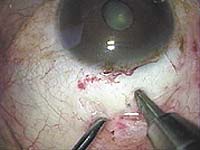 A 0.3-mm diamond blade is used to initiate a 4-by-5-mm rectangular flap based toward the limbus. PHOTOGRAPH COURTESY OF R. GALE MARTIN, MD. |
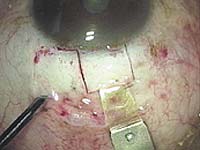 A diamond keratome is used to undermine the flap at approximately one-third scleral depth. PHOTOGRAPH COURTESY OF R. GALE MARTIN, MD. |
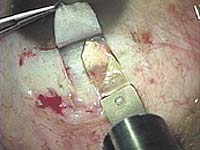 A second scleral resection is done, removing most of the posterior sclera so that gray shows through. PHOTOGRAPH COURTESY OF R. GALE MARTIN, MD. |
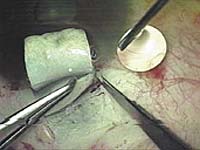 This flap is reflected over Schlemm’s canal with a round Grieshaber blade. PHOTOGRAPH COURTESY OF R. GALE MARTIN, MD. |
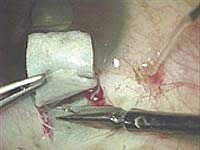 Grieshaber scissors are used to further expose Schlemm’s canal. PHOTOGRAPH COURTESY OF R. GALE MARTIN, MD. |
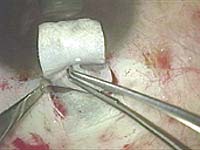 Dissection is carried anterior to Schlemm’s canal. PHOTOGRAPH COURTESY OF R. GALE MARTIN, MD. |
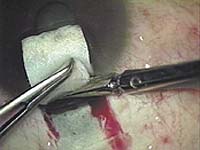 The deep scleral flap is resected with Vannas scissors. PHOTOGRAPH COURTESY OF R. GALE MARTIN, MD. |
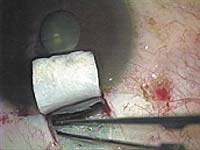 The juxtacanalicular tissue is removed. PHOTOGRAPH COURTESY OF R. GALE MARTIN, MD. |
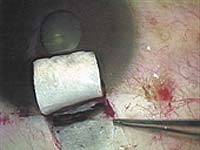 The juxtacanalicular tissue is removed. PHOTOGRAPH COURTESY OF R. GALE MARTIN, MD. |
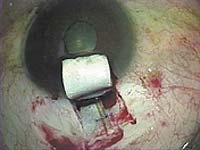 The AquaFlow stent is sutured in place with one 10-0 nylon suture. PHOTOGRAPH COURTESY OF R. GALE MARTIN, MD. |
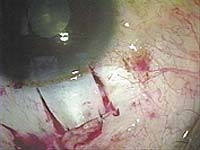 Two interrupted 10-0 nylon sutures are used to stitch the flap so that it creates a tunnel over the AquaFlow device. PHOTOGRAPH COURTESY OF R. GALE MARTIN, MD. |
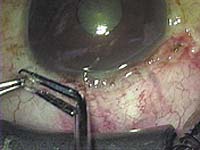 The conjunctiva is closed with wet-field cautery. PHOTOGRAPH COURTESY OF R. GALE MARTIN, MD. |
Antimetabolites as
adjuncts  To decrease toxicity and the risk of late-term complications of antimetabolite use, the application area is expanded and application time is reduced, especially in patients with lower risk for filter failure. PHOTOGRAPHS COURTESY OF RICHARD P. WILSON, MD. |
|
For Your Information:
- Robert N. Weinreb, MD, can be reached at University of California-San Diego, Glaucoma Center, 9500 Gilman Dr., La Jolla, CA 92093-0946; (858) 534-8824; fax: (858) 534-1625; e-mail: weinreb@eyecenter.ucsd.edu. Dr. Weinreb has no direct financial interest in the products mentioned in this article, nor is he a paid consultant for any companies mentioned.
- Eve J. Higginbotham, MD, can be reached at Ophthalmology Department, University of Maryland-Baltimore, 22 S. Greene St., Baltimore, MD 21201-1595; (410) 328-5929; fax: (410) 328-6346; e-mail: e-higginb@umabnet.ab.umd.edu. Dr. Higginbotham has no direct financial interest in the products mentioned in this article, nor is she a paid consultant for any companies mentioned.
- R. Gale Martin, MD, can be reached at 2170 Midland Rd., Southern Pines, NC 28387; (910) 255-2061; fax: (910) 255-2060; e-mail: rgmcea@mindspring.com. Dr. Martin has no direct financial interest in the products mentioned in this article, nor is he a paid consultant for any companies mentioned.
- Richard P. Wilson, MD, can be reached at Glaucoma Service, Wills Eye Hospital, 900 Walnut St., Philadelphia, PA 19107; (215) 928-3342; fax: (215) 928-0166; e-mail: wilson@wills-glaucoma.org. Dr. Wilson has no direct financial interest in the products mentioned in this article, nor is he a paid consultant for any companies mentioned.
- Alan L. Robin, MD, can be reached at Third Floor, 6115 Falls Rd., Baltimore, MD 21209; (410) 377-2422; fax: (410) 377-7960; e-mail: arobin@compuserve.com. Dr. Robin is a paid consultant for Pharmacia and Alcon.
